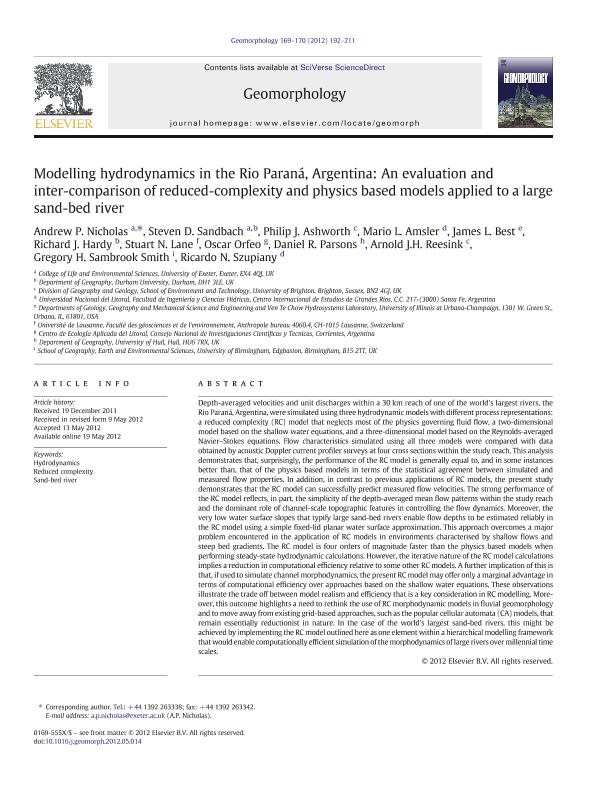Artículo
Modelling hydrodynamics in the Rio Paraná, Argentina: An evaluation and inter-comparison of reduced-complexity and physics based models applied to a large sand-bed river
Nicholas, Andrew P.; Sandbach, Steven D.; Ashworth, Philip J.; Amsler, Mario Luis ; Best, James L.; Hardy, Richard J.; Lane, Stuart N.; Orfeo, Oscar
; Best, James L.; Hardy, Richard J.; Lane, Stuart N.; Orfeo, Oscar ; Parsons, Daniel R.; Reesink, Arnold J.; Sambrook Smith, Gregory H.; Szupiany, Ricardo Nicolas
; Parsons, Daniel R.; Reesink, Arnold J.; Sambrook Smith, Gregory H.; Szupiany, Ricardo Nicolas
 ; Best, James L.; Hardy, Richard J.; Lane, Stuart N.; Orfeo, Oscar
; Best, James L.; Hardy, Richard J.; Lane, Stuart N.; Orfeo, Oscar ; Parsons, Daniel R.; Reesink, Arnold J.; Sambrook Smith, Gregory H.; Szupiany, Ricardo Nicolas
; Parsons, Daniel R.; Reesink, Arnold J.; Sambrook Smith, Gregory H.; Szupiany, Ricardo Nicolas
Fecha de publicación:
10/2012
Editorial:
Elsevier Science
Revista:
Geomorphology
ISSN:
0169-555X
Idioma:
Inglés
Tipo de recurso:
Artículo publicado
Clasificación temática:
Resumen
Depth-averaged velocities and unit discharges within a 30. km reach of one of the world's largest rivers, the Rio Paraná, Argentina, were simulated using three hydrodynamic models with different process representations: a reduced complexity (RC) model that neglects most of the physics governing fluid flow, a two-dimensional model based on the shallow water equations, and a three-dimensional model based on the Reynolds-averaged Navier-Stokes equations. Flow characteristics simulated using all three models were compared with data obtained by acoustic Doppler current profiler surveys at four cross sections within the study reach. This analysis demonstrates that, surprisingly, the performance of the RC model is generally equal to, and in some instances better than, that of the physics based models in terms of the statistical agreement between simulated and measured flow properties. In addition, in contrast to previous applications of RC models, the present study demonstrates that the RC model can successfully predict measured flow velocities. The strong performance of the RC model reflects, in part, the simplicity of the depth-averaged mean flow patterns within the study reach and the dominant role of channel-scale topographic features in controlling the flow dynamics. Moreover, the very low water surface slopes that typify large sand-bed rivers enable flow depths to be estimated reliably in the RC model using a simple fixed-lid planar water surface approximation. This approach overcomes a major problem encountered in the application of RC models in environments characterised by shallow flows and steep bed gradients. The RC model is four orders of magnitude faster than the physics based models when performing steady-state hydrodynamic calculations. However, the iterative nature of the RC model calculations implies a reduction in computational efficiency relative to some other RC models. A further implication of this is that, if used to simulate channel morphodynamics, the present RC model may offer only a marginal advantage in terms of computational efficiency over approaches based on the shallow water equations. These observations illustrate the trade off between model realism and efficiency that is a key consideration in RC modelling. Moreover, this outcome highlights a need to rethink the use of RC morphodynamic models in fluvial geomorphology and to move away from existing grid-based approaches, such as the popular cellular automata (CA) models, that remain essentially reductionist in nature. In the case of the world's largest sand-bed rivers, this might be achieved by implementing the RC model outlined here as one element within a hierarchical modelling framework that would enable computationally efficient simulation of the morphodynamics of large rivers over millennial time scales. © 2012 Elsevier B.V.
Palabras clave:
Hydrodynamics
,
Reduced Complexity
,
Sand-Bed River
Archivos asociados
Licencia
Identificadores
Colecciones
Articulos(INALI)
Articulos de INST.NAC.DE LIMNOLOGIA (I)
Articulos de INST.NAC.DE LIMNOLOGIA (I)
Citación
Nicholas, Andrew P.; Sandbach, Steven D.; Ashworth, Philip J.; Amsler, Mario Luis; Best, James L.; et al.; Modelling hydrodynamics in the Rio Paraná, Argentina: An evaluation and inter-comparison of reduced-complexity and physics based models applied to a large sand-bed river; Elsevier Science; Geomorphology; 169-170; 10-2012; 192-211
Compartir
Altmétricas



